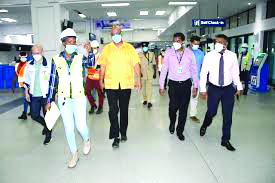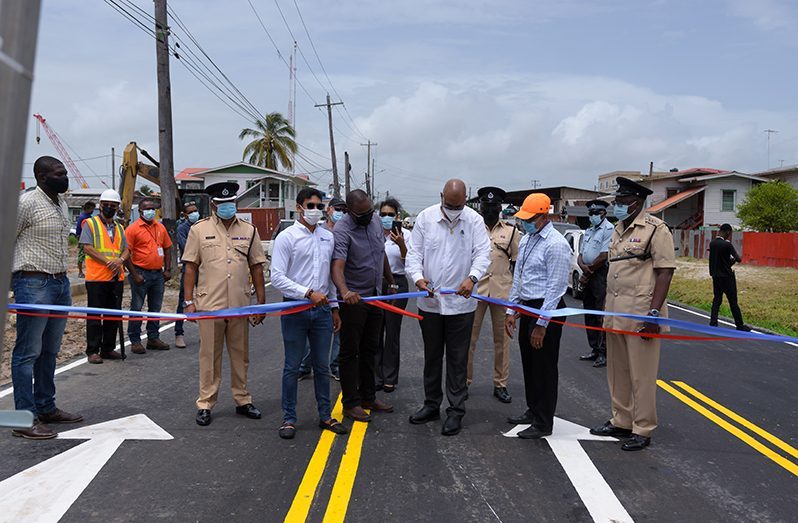–billions of dollars allocated, expended to enhance local infrastructure
FOR Guyana to move ahead and transition into a new economy, the right conditions need to be created to facilitate investments and advancements across all sectors.
Cognisant of the fact that a ‘sturdy’ foundation is needed to create an environment that is conducive to business and investments, the government has, over the past year, embarked on a drive to transform the infrastructural landscape of the country.
This year alone, the government plans to expended close to $172.4 billion or 45 per cent of its $383.1 billion budget on education, public infrastructure and healthcare. Of this, $58.2 billion of planned expenditure on public infrastructure is the second largest component of the government’s fiscal programme.
On the capital side, the budget for infrastructure is $32.9 billion or 32 per cent of the total allocation for 2021. The country’s aggregate capital provision for this year is $103 billion.
This investment, according to the Georgetown Chamber of Commerce and Industry (GCCI), in its message following the announcement of Budget 2021, provides the financial grounding for the ‘buildout’ of the country’s infrastructure and the basis for re-starting economic growth, which would have been hindered by a protracted electoral process and the pervasive COVID-19 pandemic.

The 2021 budget followed the emergency budget of 2020, which was prepared under a compressed schedule, and arrived in the National Assembly well into the second half of the fiscal year, as a result of the protracted March 2, 2020 General and Regional Elections.
“That emergency budget delivered on this PPP/C Government’s promise to provide immediate protection and relief to the long-suffering people of Guyana, and breathe some life into the then moribund Guyanese economy,” Senior Minister in the Office of the President with responsibility for Finance, Dr. Ashni Singh, had said during his five-hour-long presentation to the National Assembly early this year. In moving forward, construction, the sector with one of the highest multiplier effects in the economy, is anticipated to provide employment and spinoff effects to catalyse economic growth. According to an American research group, the Brookings Institution, infrastructure enables trade, powers businesses, connects workers to their jobs, creates opportunities for struggling communities and protects the nation from an increasingly unpredictable natural environment.
From private investment in telecommunication systems, broadband networks, freight railroads, energy projects and pipelines, to publicly spending on transportation, water, buildings and parks, infrastructure is the backbone of a healthy economy.
The research group has determined that an economy needs reliable infrastructure to connect supply chains and efficiently move goods and services across borders.
From the onset, when the People’s Progressive Party/Civic (PPP/C) was elected to office in August, 2020, the Minister of Public Works, Juan Edghill, had said his ministry will not be working in isolation but will be moving swiftly towards achieving the government’s development agenda.
Evidently, the minister intends on staying true to his word, as there are clear plans in place to enhance the infrastructural landscape of the country and prepare for the “new economy.”
“You have to prepare for the new economy. The economy before you is an expanding oil and gas sector, and we will need infrastructure onshore to move goods, people and services more efficiently and cheaper,” Minister within the Ministry of Public Works, Deodat Indar, had said during a recent interview.
The country’s potential economic growth is reflected by the NASDAQ Stock Market in a report published in October 2020, which states that Guyana will remain as the fastest growing economy in the world.
Guyana grew at an extraordinary rate of 43.5 per cent in 2020, having completed a year of oil production. The positive spinoff effects were, however, dampened by a deep contraction in the non-oil economy, triggered by measures to contain the COVID-19 pandemic.
But despite the lingering adversities, projections remain positive, with the country set to record economic growth of 20.9 per cent at the end of 2021, 26.0 per cent in 2022 and 23.0 per cent in 2023. The country’s Gross Domestic Product (GDP) of about $6.8 billion is expected to more than double by 2025, reaching over $14 billion.
In light of this, President, Dr. Irfaan Ali, had said that the right infrastructure is needed to accompany development and catalyse transformation.
BUILD AND MODERNISE
Early this year, the President said: “We need to have the right infrastructure. We have to build and modernise and do what is necessary for growth and development, but there cannot be an overreach and over spending… critical infrastructural links have to and will be created.”
Already, the government is building roads and bridges, and enhancing existing infrastructure which will serve as arteries to development.
Speaking specifically about some of the major projects in the pipeline, Indar had said that the government had advertised for Expressions of Interest (EoIs) for the construction of a bridge across the Corentyne River, connecting Guyana to Suriname.
Further, the government is moving ahead with plans for the construction of a new bridge across the Demerara River. The new four-lane high-span bridge, which is scheduled to be completed in three years after the commencement of work, will replace the existing structure which was built in 1976, over four decades ago.
Another critical infrastructural link is the Ogle to Haags Bosch four-lane highway. This project is being funded by the Government of India to the tune of US$50 million.
“We expect work on this [project] to start in the last quarter of this year, after the procurement process is finished,” Minister Indar said.
In this time, the government will be commissioning studies for a four-lane highway from Schoonard on the West Bank of Demerara to Parika on the East Bank of Essequibo. This project forms part of a wider initiative to create direct linkage to Bartica, Region Seven (Cuyuni-Mazaruni).
According to Minister Indar, there are plans to connect Goshen to Monkey Jump, both in Region Ten (Upper Demerara-Berbice), and subsequently Monkey Jump to Bartica. Also, there are plans to connect Parika to Timehri and Timehri through Mabura to Monkey Jump.
This will be supplemented by the construction of 125 kilometers of road from Linden to Mabura Hill.
“This a big one… it will cost about US$192 million and tenders are already out for it,” Minister Indar related.
One of the main connectors to Georgetown– Hunter Street, West Ruimveldt– was reopened recently after contractor, Vieira 66 Logistics, wrapped up upgrades to the former double lane road and transformed it into a major thoroughfare with three lanes.
The government’s total budget for road programmes is $23.7 billion, $7.9 billion of which will go specifically towards the development of community roads. Of the budgeted sum, $2.1 billion has been set aside for hinterland roads and the rehabilitation of a number of hinterland airstrips.
“We are doing a lot in terms of infrastructure… we are looking at pavements, parks and other areas of infrastructure development,” Minister Indar said, noting that there is also the expansion of the Cheddi Jagan International Airport and other projects which are ongoing.
Key points on infrastructure:
* The budget for infrastructure is $32.9 billion or 32 per cent of the total allocation for 2021
* Moving ahead with plans for the construction of a new bridge across the Demerara River
* India-funded Ogle to Haags Bosch four-lane highway could start in the last quarter of this year
* Studies to be initiated for a four-lane highway from Schoonard on the West Bank of Demerara to Parika on the East Bank of Essequibo
* Plans to connect Goshen to Monkey Jump, both in Region Ten (Upper Demerara-Berbice), and subsequently Monkey Jump to Bartica
* $150 million expended to upgrade Hunter Street




.jpg)










